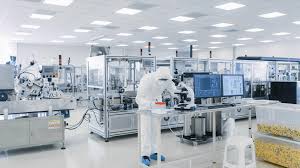Designing
a pharmaceutical manufactory is a complex process, requiring meticulous
attention to detail to ensure compliance with strict regulations, safety, and
quality control standards. Here's a deep dive into the key aspects of a
well-designed pharmaceutical manufacturing facility:
1. Layout and Zoning:
- Segregation of Areas: The
facility should be divided into distinct zones for raw materials,
production, packaging, quality control, and warehousing, preventing
cross-contamination.
- Controlled Environments: Each zone
should have controlled temperature, humidity, and air pressure to maintain
the stability of drugs and prevent microbial growth.
- Material Flow: The
layout should optimize material flow, minimizing the risk of errors and
ensuring efficient production.
2. Cleanroom Design:
- Air Filtration:
High-efficiency particulate air (HEPA) filters and ultra-low penetration
air (ULPA) filters are crucial to maintain a sterile environment and
prevent airborne contamination.
- Airflow Control:
Directional airflow ensures contaminants are removed from occupied areas
and prevents cross-contamination.
- Surface Materials: Walls,
floors, and ceilings should be smooth, non-porous, and easy to clean and
disinfect.
3. Equipment and Technology:
- Automated Systems: Automated
equipment minimizes human intervention, reducing the risk of errors and
contamination.
- Monitoring and Control Systems: Real-time monitoring of temperature, humidity, pressure, and
other critical parameters is essential for process control and quality
assurance.
- Validation and Calibration: Equipment and systems should be regularly validated and
calibrated to ensure accuracy and reliability.
4. Utilities and Infrastructure:
- Water Purification System: A reliable water purification system is essential to provide
high-quality water for various processes.
- Waste Management System: Proper
disposal of hazardous waste is crucial to protect the environment and
comply with regulations.
- Backup Systems: Uninterrupted
power supply and backup systems for critical equipment are essential to
prevent production disruptions.
5. Regulatory Compliance:
- Current Good Manufacturing Practices (cGMP): The facility must adhere to cGMP
regulations to ensure the safety, quality, and efficacy of pharmaceutical
products.
- Validation and Qualification: Processes, equipment, and systems should be validated and
qualified to demonstrate compliance with cGMP requirements.
- Regulatory Inspections: The
facility should be designed to facilitate inspections by regulatory
agencies.
Additional Considerations:
- Sustainability: Implementing
energy-efficient practices and reducing waste can benefit the environment
and reduce operating costs.
- Scalability: The
design should be flexible enough to accommodate future growth and
expansion.
- Employee Safety: The
facility should be designed to ensure the safety and well-being of
employees.
Remember, this is a general
overview, and the specific design of a pharmaceutical manufactory will vary
depending on the type of drugs being manufactured, production volume, and other
factors. Consulting with experienced professionals in pharmaceutical manufacturing
and regulatory compliance is crucial to ensure a successful design that meets
all requirements.
By
following these principles and incorporating the latest technologies and best
practices, you can design a pharmaceutical manufactory that is safe, efficient,
and compliant with all regulations, ultimately contributing to the production
of high-quality medications for patients worldwide.


add comment